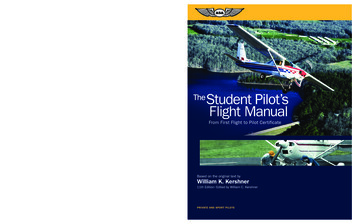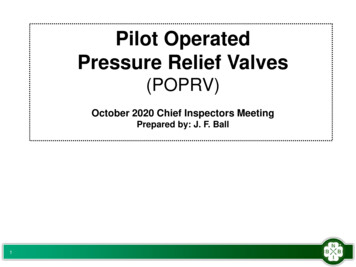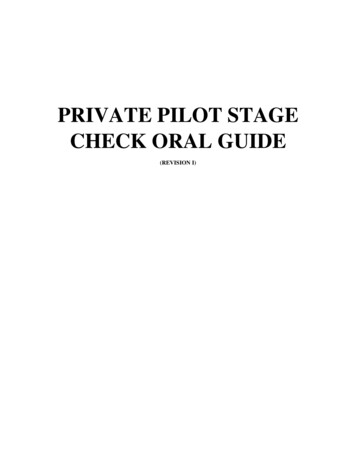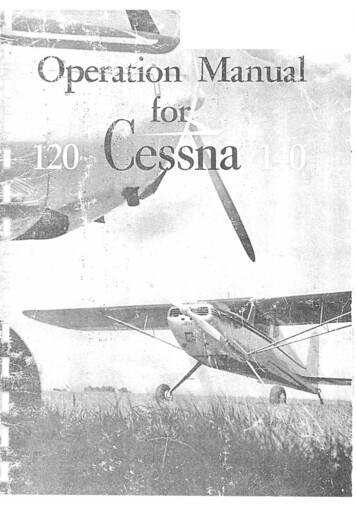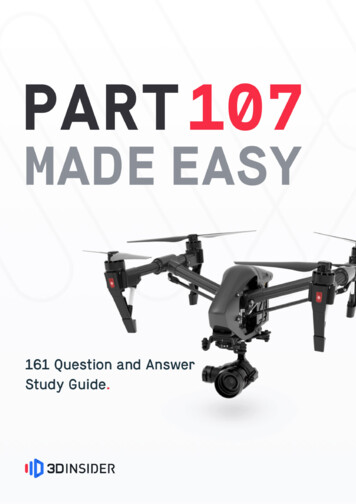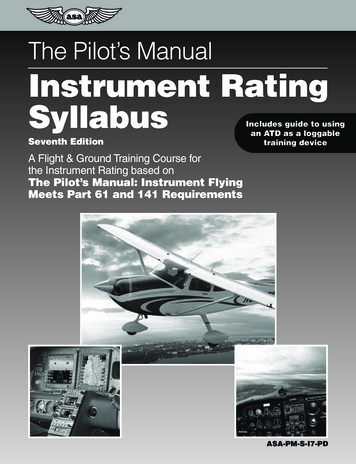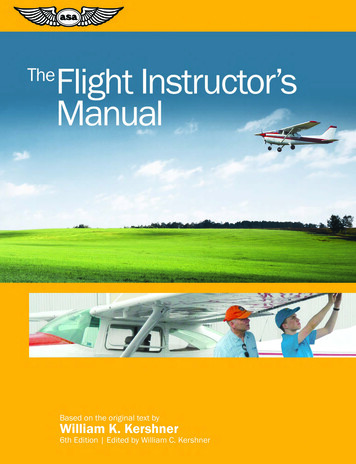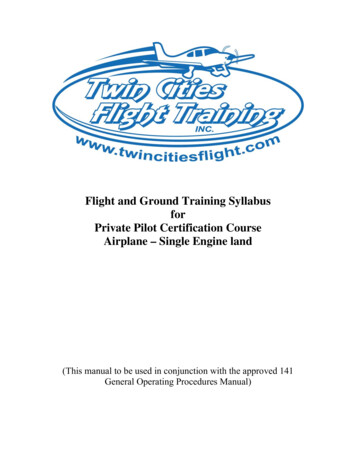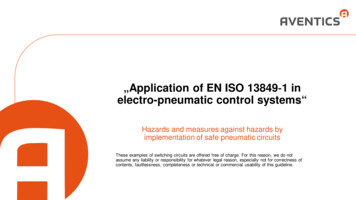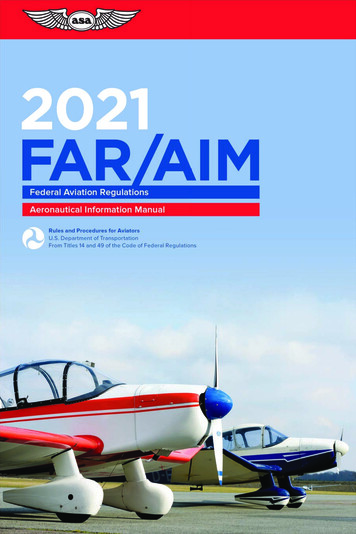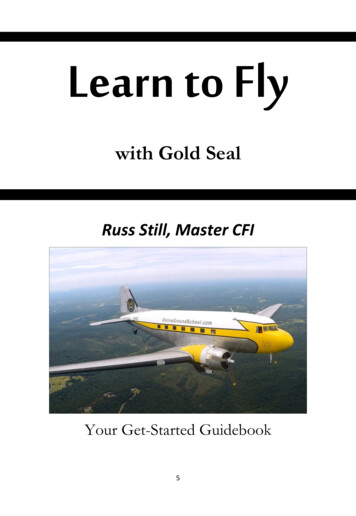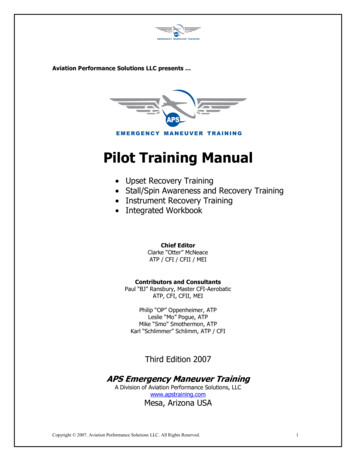
Transcription
Aviation Performance Solutions LLC presents Pilot Training Manual Upset Recovery TrainingStall/Spin Awareness and Recovery TrainingInstrument Recovery TrainingIntegrated WorkbookChief EditorClarke “Otter” McNeaceATP / CFI / CFII / MEIContributors and ConsultantsPaul “BJ” Ransbury, Master CFI-AerobaticATP, CFI, CFII, MEIPhilip “OP” Oppenheimer, ATPLeslie “Mo” Pogue, ATPMike “Smo” Smothermon, ATPKarl “Schlimmer” Schlimm, ATP / CFIThird Edition 2007APS Emergency Maneuver TrainingA Division of Aviation Performance Solutions, LLCwww.apstraining.comMesa, Arizona USACopyright 2007. Aviation Performance Solutions LLC. All Rights Reserved.1
COURSE INTRODUCTIONAs the President of Aviation Performance Solutions, I would like to thank you for your decisionto participate in our specialized courses of training. In preparation for your APS program, wehave provided this training manual as a reference to be used at your discretion. For yourconvenience and future reference, we have also included a Notes section in the back of thisbooklet for you to jot down your thoughts during your visit. Please enjoy your stay with us andtake a moment to review the resources we have brought together to provide this training.Our CommitmentOur team is committed to providing the highest quality upset recovery training, aerobaticsinstruction, spin recovery and instrument recovery training available in the industry at the bestvalue for your training dollar.APS Emergency Maneuver Training ensures our clients are in the hands of highly trained andexperienced professional aviators. Our staff excels in quality customer service and, in addition toproviding world-class training in leading-edge equipment, we put the customer second only toflight safety. Moreover, we ensure our training services are being delivered in strict adherence tothe industry's highest performance standards. Our business philosophy integrates quality trainingamidst an easy-going and enjoyable atmosphere.InstructorsEach one of our instructor pilot’s professional flight experience spans a highly specializedspectrum of aviation that uniquely qualifies them as the ideal training providers. All haveextensive experience in general aviation, aerobatic maneuvering, military flight instruction, andall have experience flying technologically advanced aircraft in commercial and/or transportcategory flight operations.As a testament to our dedication to the quality of our instructor staff, the APS President and ChiefFlight Instructor is one of only eleven NAFI Master CFIs in the United States to receive"aerobatic" accreditation out of a field of over 90,000 CFIs and nearly 500 Master CFIsnationwide.FacilitiesAll APS training courses are headquartered in our modern corporate hangar/office facilitycentrally located at the Williams Gateway Airport in Mesa, Arizona. Arguably, Arizona boaststhe nation’s most consistently favorable VFR weather conditions supporting everyone's need forreliable course scheduling.The Industry StandardThese key assets of personnel and infrastructure combined with our 10-years of businessexperience have helped us establish the industry standard. We’ve been constantly refining upsetrecovery training techniques common to all categories of fixed wing aircraft and this has helpedto make APS an unparalleled training resource to the aviation community.In addition to all training being in compliance with the FAA Upset Recovery Training AidRevision 1, APS Emergency Maneuver Training (to our knowledge) is the only Part 141 FlightSchool certified upset recovery, spin and instrument recovery training course provider in thenation.Copyright 2007. Aviation Performance Solutions LLC. All Rights Reserved.2
Training AircraftAPS Training exclusively employs the German-built Extra 300L. In addition to being the world’shighest performance certified aerobatic aircraft, the Extra 300L is one of the safest, moststructurally sound aircraft available and is ideally suited for upset recovery and advancedaerobatics training. This aircraft is fully aerobatic, equipped with multiple-view digital videosystems and certified by the FAA to a /- 10 G envelope for your team’s safety.Despite the Extra’s superior performance and capabilities, all maneuver-based and scenario-basedtraining exercises are taught in a manner that ensures each student is trained to apply recoverytechniques within the performance envelope of their specific aircraft.Training ObjectivesOur upset recovery and emergency maneuver training courses teach every participant to recoverfrom any possible in-flight upset or flight envelope excursion. Most importantly, APS trainingprograms are focused on promoting “Recognition and Avoidance” through flight trainingintegrated with a thorough theoretical understanding of the aerodynamics involved with eachpotential flight condition. To accomplish this, we do immerse pilots into the world of unusualattitude and uncommon flight envelope conditions while instilling participants with effectiverecognition, avoidance and recovery capabilities.Graduates can expect the development of: Increased awareness of all upset scenariosEarly recognition and avoidance skills through practical experience andunderstandingDecisive recovery techniquesLeadership skills and judgment in high pressure, time critical flightenvironmentsEnhanced multi-crew cockpit management skills during an upsetImproved safety of flightA Final WordThank you for joining our team for the next few days. We look forward to sharing our trainingwith you. We’re confident you will learn skills and develop insights during your course that willlast a lifetime.With sincere appreciation,Paul BJ Ransbury, PresidentMaster Flight InstructorAPS Emergency Maneuver TrainingCopyright 2007. Aviation Performance Solutions LLC. All Rights Reserved.3
TABLE OF CONTENTSCOURSE INTRODUCTION.2TABLE OF CONTENTS .4CHAPTER 1: GENERAL INFORMATION .6101 FACILITY LOCATION .6102 INSTRUCTOR PILOTS .7103 TRAINING AIRCRAFT.9CHAPTER 2: REGULATIONS & SAFTEY.10201 REGULATIONS .10202 FLIGHT PREPARATION .11CHAPTER 3: RELEVANT THEORY OF FLIGHT .12301 GENERAL TERMINOLOGY¹ .12CHAPTER 4: FACTORS AFFECTING DISORIENTATION .18401 EFFECTS OF ACCELERATION FORCES (G-FORCES).18402 SPATIAL DISORIENTATION.20403 CAUSES OF SPATIAL DISORIENTATION (SD) .22402 PREVENTION OF SPATIAL DISORIENTATION MISHAPS .23403 MINIMIZING MOTION SICKNESS.23CHAPTER 5: EMERGENCY MANEUVER EXERCISE GUIDE .26THE “SAY & DO” TECHNIQUE .26PSSA: PRE-STALL / SPIN AEROBATIC CHECK.28EXERCISE #1: HANDLING / ATTITUDES / STEEP TURNS .29EXERCISE #2: DUTCH ROLLS .31EXERCISE #3: ZOOM MANEUVER .33EXERCISE #4: SLOW SPEED MANEUVERING .35EXERCISE #5: UNACCELERATED STALLS .37EXERCISE #6: FALLING LEAF (RUDDER STALL EXERCISE) .40EXERCISE #7: THE AILERON ROLL .42EXERCISE #8: THE INSIDE LOOP .44EXERCISE #9: INVERTED FLIGHT.46Copyright 2007. Aviation Performance Solutions LLC. All Rights Reserved.4
EXERCISE #10: NEGATIVE ROLL DAMPING EXERCISE .48EXERCISE #11: SKIDDED TURN STALLS .50EXERCISE #12: SLIPPING TURN STALLS.53EXERCISE #14: SPLIT-S (½ ROLL & PULL-THROUGH) .58EXERCISE #15: THE CUBAN 8 .60EXERCISE #16: POWER OFF APPROACH TO LANDING.62EXERCISE #16: POWER OFF APPROACH TO LANDING.63EXERCISE #17: UNUSUAL ATTITUDE RECOVERIES .65EXERCISE #18: THE HAMMERHEAD.69EXERCISE #19: IMMELMAN (THE ROLL-OFF-THE-TOP).72EXERCISE #20: SIMULATED CONTROL LOSS .73EXERCISE #20: SIMULATED CONTROL LOSS .74EXERCISE #21: INCIPIENT SPIN RECOVERIES .78EXERCISE #22: FULLY-DEVELOPED SPIN RECOVERIES.80EXERCISE #23: AGGRAVATED & INVERTED SPIN MODES .83EXERCISE #24: INADVERTENT SPIN RECOVERIES .86CHAPTER 6: NOTES .88HANDOUTS and INSERTS:On arrival at APS Emergency Maneuver Training, you will receive:oooMission Exercise SummariesInstrument Recovery Training SupplementVarious Articles Applicable to Your Selected Course of Training as Determined byYour Course Instructor(s)Copyright 2007. Aviation Performance Solutions LLC. All Rights Reserved.5
CHAPTER 1: GENERAL INFORMATION101 FACILITY LOCATIONPlease visit our website for more detailed maps:http://www.apstraining.com/fci directions.htmWilliams Gateway Airport, home and headquarters for APS Emergency Maneuver Training, islocated in the Phoenix metropolitan area in southeast Mesa, Arizona.From US Highway 60: exit at Power Road – Exit 188 (DO NOT TAKE THE SOSSAMANROAD EXIT FROM US 60). Merge onto and proceed south on Power Road approximately 4.5miles to the intersection of Power Road and E Ray Road. Turn left on E Ray Road. Ray Road willveer sharply to the right after approximately ¼ mile and the road becomes South Sossaman Road.From the San Tan Freeway Loop 202 – exit onto Power Road – Exit 36. Proceed south onPower Road for ½ mile to the intersection of Power Road and E. Ray Road. Turn left on E RayRoad. Ray Road will veer sharply to the right after approximately ¼ mile and the road becomesSouth Sossaman Road.Once on Sossaman Road you will have a reasonable view of the runways on the left and a golfcourse on the right as you proceed toward the main section of the airport. APS EmergencyManeuver Training facility is the 5th building on the left side of the road – bldg #5865, a brandnew 25,000 square foot 2-story complex, located just beyond the Williams Gateway AirportAdministration office. The building facade features a frontal view of two aircraft in formation.APS Emergency Maneuver Training5865 S. Sossaman Road.Mesa, Arizona 85212Toll-free: 866-359-4273Tel: 480-279-1881Copyright 2007. Aviation Performance Solutions LLC. All Rights Reserved.6
102 INSTRUCTOR PILOTSPaul "BJ" Ransbury, PresidentAerobatic, Upset Recovery & Spin Training InstructorInstructor Qualifications:NAFI Master CFI-AerobaticPart 141 Chief Flight InstructorCertified Flight Instructor (CFI) Multi-Engine Instructor (MEI)Instrument Instructor Airplane (CFII) Advanced Ground Instructor (AGI)FITS: Cirrus Standardized Instructor (CSI) SR22/20Military - Bombardier Flying Instruction Techniques Course GraduateMilitary - Fighter Weapons Instructor Course GraduateProfessional Pilot Experience and Certifications:Airline Transport Pilots License, Single/Multi-Engine IFR (US & CAN)Airlines: A320 AirbusTailwheel / Complex / High-Performance Certified2500 hours Extra 300L ExperienceMemberships: NBAA, AOPA, TBMOPA, MMOPA, EAA, IAC, NAFI, ICASMilitary Fighter Pilot Experience:12 Yrs CAF: F/A-18 Hornet Fighter PilotFighter Electronic Warfare and Advanced Radar Graduate416 Tactical Fighter Squadron 425 Tactical Fighter SquadronAir Show Qualifications:ICAS Certified Air Show Performer - Solo/Formation AerobaticsEducation:BSc Honors Mathematics & Physics Degree Royal Military College of CanadaPursuing MBA - University of PhoenixClarke “Otter” McNeaceAerobatic, Upset Recovery & Spin Training InstructorDirector of Flight Training / Check PilotPart 141 Assistant Chief Flight InstructorCertified Flight Instructor (CFI) / Advanced Ground Instructor (AGI)Multi-Engine Instructor (MEI) / Instrument Instructor Airplane (CFII/MEII)11,000 Flight HoursU.S. Navy: 8 yrs active dutyF/A-18 Hornet Instructor Fighter Weapons InstructorStrike Phase Instructor Landing Signal Officer (LSO) with Training Qual36 combat missions: Desert Storm/ Southern Watch300 carrier-arrested landings:USS Midway, USS Independence, USS Nimitz,USS America, USS LexingtonAirline Transport Pilot - 10 years Airline Captain, B-737 - 5 yearsTailwheel, Complex, Sailplane endorsementsB.S. Computer Science, University of KansasMike "Smo" SmothermonAerobatic, Upset Recovery & Spin Training Instructor20 Years USAF: Lt. Col, F-16, A-10 Fighter PilotInstructor Course Graduate - F16308th Fighter Squadron Commander, Luke AFB, AZ80th Fighter Squadron Operations Officer, Kunsan AB, Korea61st Fighter Squadron Assistant Ops Officer, MacDill AFB, FL526th Fighter Squadron Flight Commander, Ramstein AB, GE509th Fighter Squadron, Bentwaters, UKAirline Transport Pilot's License, B-737 800/200Flight Engineer, B-727Univ. of Southern California System Safety SchoolMBA - Boston University - BSc, Operations Research - USAF AcademyCopyright 2007. Aviation Performance Solutions LLC. All Rights Reserved.7
Philip “O.P.” OppenheimerAerobatic, Upset Recovery & Spin Training Instructor20 Years USAF: F-16, A/OA-37, A-10 Fighter PilotInstructor Course Graduate - F16, A10, AT3728 Combat Missions DESERT SHIELD / STORM 1990-1991 (F-16)356th Tactical Fighter Squadron (A-10)24th Comp/Tac Air Support Squadron (A/OA-37)4th Fighter Squadron, Hill AFB, UT (F-16)421st Fighter Squadron, Hill AFB, UT (F-16)310th Fighter Squadron (F-16 Ops Officer)309th Fighter Squadron (F-16 Commander)Airline Transport Pilots License, BE-400, MU-300USDA Interagency USDI Single Engine Air Tanker Firefighting PilotBS Education, Math & Physics, Texas A&M UniversityMA Military Studies, Air Warfare, AMU"Stormin' " Norman RennspiesAerobatic, Upset Recovery & Spin Training Instructor20 Years USAF: F-16, A-10 Fighter PilotInstructor Course Graduate - F16, A10USAF Fighter Weapons School GraduateCombat Vet DESERT SHIELD / STORM / SOUTHERN WATCH1990-1998 (A-10,F-16)25th Tactical Fighter Squadron (A-10) Suwon Korea92nd Tactical Fighter Squadron (A-10) RAF Bentwaters356th Fighter Squadron (A-10) Myrtle Beach, SC.94 Training Squadron (TG-7A) USAF Academy, Co.68th Fighter Squadron (F-16 ) Moody, GA.61st Fighter Squadron (F-16) Luke AFB, AZ.56th Training Squadron (F16 Chief Academic Instructor) Luke AFB, AZPeace Vector IV (F16 Commander) Gianaclis AB, EgyptAirline Transport Pilots LicenseAirlines: Boeing 737, Airbus A320/319/321B.S. General Engineering, USAF Academy, Co.M.S. Management, Troy State University, European RegionBill ‘Muff’ MoffatAerobatic, Upset Recovery & Spin Training InstructorCanadian Air Force: 15 yrs active duty - F/A-18 Hornet InstructorFighter Electronic Warfare and Advanced Radar InstructorWing Tactical Evaluation PilotCanadian Air Force F/A-18 Demonstration PilotUnited States Navy F/A-18 Instructor Pilot Carrier QualifiedTheatre of Duty: KosovoAirline Transport Pilot Airlines:B-737, K&S Aviation 737 Instructor PilotTailwheel, Complex, Sailplane endorsementsB. Comm, Dalhousie UniversityCopyright 2007. Aviation Performance Solutions LLC. All Rights Reserved.8
103 TRAINING AIRCRAFTYour safety is our top priority. The APS fleet of German-built Extra 300Ls are a perfect fit to ourtraining programs. Although we teach our course to the performance and capabilities of yourspecific aircraft, the Extra is certified to /- 10Gs, has no prohibited maneuvers and boasts a maxgross climb rate in excess of 3200 fpm, making it one of the safest and most capable aircraft inthe sky.As an added benefit, each aircraft is equipped with a multi-view digital video and audio systemthat records the entire flight for use as a teaching tool after the flight and as a keepsake to reviewor to show your family and friends.As the world’s most successful unlimited category aerobatic aircraft, the two-seat Extra 300Lremains unrivalled in its class. Its proven performance in international aerobatic competition,combined with its docile handling and dependable stability, translate into a comfortable crosscountry touring machine. For pure power, handling and performance, nothing matches thisaircraft.SpecificationsLength. 22.83'Height . 8.6'Span. 25.25'Engine. Textron Lycoming AEIO540L1B5, 300 HP fuel injectedPropeller . MT Constant Speed Propeller, 3 blade standardInverted Oil System. Christen IndustriesFuelTotal Fuel Capacity . 45.1 gallonsUseable Fuel - Standard Tanks. 44.6 gallonsTotal Fuel Capacity - Long Range Tanks. 55.1 gallonsUseable Fuel - Long Range Tanks . 54.5 gallonsAirspeedsNever Exceed Speed (Vne) . 220 ktsManeuvering Speed (Va). 158 ktsStall Speed @ 1800 lbs. 55 ktsStall Speed @ 2095 lbs. 60 ktsTake-Off Performance: Standard Day @ Sea Level @ Gross WeightGround Run . 653'Total: Clear 50 foot obstacle . 1789'PerformanceMaximum demonstrated @ 90o crosswind component . 15 ktsMaximum Rate of Climb at Sea Level . 3200 fpmService Ceiling .16,000 feetMax Range Standard Tanks @ 8000 and 170 kts TAS415 nm plus 45 minute reserve @ 45% powerLong Range Tanks @ 8000 feet and 170 kts TAS . 510 nm plus 45 minute reserve @ 45% powerWeight and BalanceStandard Empty Weight . 1440 lbsGross Weight. 2095 lbsMaximum Useful Load . 655 lbsCopyright 2007. Aviation Performance Solutions LLC. All Rights Reserved.9
CHAPTER 2: REGULATIONS & SAFTEY201 REGULATIONS1) In the FARs, aerobatic flight is described as “maneuvers intentionally performed by anaircraft, involving an abrupt change in its altitude, an abnormal attitude, or an abnormalvariation in speed.”2) Part 91 of the Federal Aviation Regulations outlines specific items pertaining to aerobatic andformation flight. APS Emergency Maneuver Training operates in accordance with its FAACertificate of Waiver or Authorization (FAA Form 7711-1) to ensure compliance with FARs91.111, 91.303 and 91.307FAR 91.303 - Aerobatic FlightNo person may operate an aircraft in aerobatic flight (a) Over any congested area of a city, town, or settlement;(b) Over an open air assembly of persons;(c) Within the lateral boundaries of Class B, Class C, Class D, or Class E airspacedesignated for an airport;(d) Within 4 nautical miles of the centerline of any Federal airway;(e) Below an altitude of 1,500 feet above the surface; or(f) When flight visibility is less than 3 statute miles.FAR 91.307 – Parachutes and Parachuting(c) Unless each occupant of the aircraft is wearing an approved parachute, no pilot of a civilaircraft carrying any person (other than a crewmember) may execute any intentional maneuverthat exceeds –(1) A bank of 60 degrees relative to the horizon; or(2) A nose-up or nose-down attitude of 30 degrees relative to the horizon.Copyright 2007. Aviation Performance Solutions LLC. All Rights Reserved.10
202 FLIGHT PREPARATIONPREFLIGHT1) Preflight inspection and control of ALL LOOSE ARTICLES cannot be over-emphasized.2) Personal Preparation in the Cockpita) Straps tightb) Headset securec) Full rudder deflection easily achieved – even under negative G(knees should be bent at no more than a 120 degree angle with full rudder deflectionsitting on the ground after strap-in)d) Confirm full-range of control column and rudder deflection availableINFLIGHT1) Prior to every aerobatic maneuver, or sequence of maneuvers, the pilot in command willensure that the airspace is clear of traffic and that a Pre-Stall-Spin-Aerobatic (PSSA) check iscarried out. This check will consist of:a) PSSA (Pre-Stall-Spin-Aerobatic) Checki) Altitudeii) Areaiii) Loose Articlesiv) Temperatures and Pressuresv) Fuel & Engine Parametersvi) Clearing turns appropriate to the maneuver (in order of preference):(1) 2 X 90 degree level turns or wing-over (Lazy Eight-like) maneuvers in oppositedirections(2) 180 degree turn2) It is the instructor’s responsibility to ensure that each student is aware of all safety factorsrelated to aerobatic flight. Although this document covers the key elements of eachmaneuver, every pilot must be ready to “centralize the controls and analyze” any peculiarsituation whenever the maneuver or sequence of maneuvers becomes unfamiliar. Botchedmaneuver recovery techniques will be taught throughout the course.Copyright 2007. Aviation Performance Solutions LLC. All Rights Reserved.11
CHAPTER 3: RELEVANT THEORY OF FLIGHTUnlike the Wright brothers and pilots of early days, the modern pilot has the burden of dealingwith a complex web of structured airspace, burdening regulations, and sophisticated equipment.Much of a pilot’s training today is committed to managing these complex areas that can be atremendous distraction. As a student pilot (we are all “students” of aviation, no matter yourexperience) we must give due consideration to developing skills to safely handle our aircraft inany adverse flight condition. With Loss-of-Control in flight being one of the leading causes offatal aviation accidents worldwide, it is important that we not dismiss stall-awareness and upsetrecovery training as trivial.Statistics demonstrate that the scenarios presented in the APS courses of training can threatenyour safety, if not your very life, and could happen on any given day. Let’s start the preparationthrough academic study. We will be applying each of the concepts presented in this chapter in amanner that clearly explains their application to recovering an aircraft. Understanding pertinentprinciples of flight pertaining to emergency maneuver training enables us to appreciate the effectof airflow on stability and control at varying speeds, angles of attack and flight attitudes.301 GENERAL TERMINOLOGY¹1) An airplane is in upright flight whenever the pitch or bank angle is within 90 of its upright,wings-level attitude relative to the horizon.2) An airplane is in inverted flight whenever the pitch or bank angle is exceeds 90 from anupright, wings-level attitude relative to the horizon. NOTE: Just because an aircraft isinverted, does not mean it is experiencing negative G’s or a negative angle of attack.3) Coordinated flight occurs whenever the pilot is proactively canceling the adverse yaw effectsassociated with power (engine / propeller effects), aileron inputs, and airplane rigging. Wewould experience uncoordinated flight otherwise.4) Relative wind is the net wind presented to a lifting surface such as the main wing of anairplane. For our purposes, relative wind could be made up of several components: the windresulting from the forward progress of the airplane through the air, the wind resulting fromyawing or side-slipping.5) Angle of Attack (AOA) refers to the angle formed between the chordline of a given wing,airfoil, or any other lifting surface, and the net relative wind. In positive G flight, the winghas a positive angle of attack and the Lift vector points through the top surface of the wing.In negative G flight, the wing has a negative angle of attack and the Lift vector pointsthrough the bottom surface of the wing.6) Adverse Yaw is the yaw associated with deflected aileron inputs. A downward deflectedaileron in normal flight produces more lift; hence, it also produces more drag. This addeddrag attempts to yaw the airplane’s nose in the direction of the raised wing.Copyright 2007. Aviation Performance Solutions LLC. All Rights Reserved.12
7) Critical Angle of Attack refers to the AOA representing the maximum coefficient of lift of awing, airfoil, or other lifting surface. Every wing has at least two critical angles of attack:one positive, one negative. The positive critical angle of attack in a light airplane typicallyoccurs in the range of ten to twenty degrees AOA. Critical values can be in excess of 35AOA in modern fighter aircraft.8) A spiral is nothing more than a turn during which the altimeter changes. An airplane in aspiral is not stalled.9) A graveyard spiral usually occurs during IMC or marginal VMC flight. The resultingaccident is often fatal and is typically driven by false or conflicting information from thevisual and vestibular systems.10) G-load or Load factor is the ratio of the total air load acting on the airplane to the grossweight of the airplane. For example, a load factor of 3 means that the total load on anairplane’s structure is three times its gross weight. Load factor is usually expressed in termsof “G’s” – that is, a load factor of 3 may be spoken of as 3 G’s.11) Torque Components (left turning tendency of aircraft with right-turning propellers) is madeup of four elements that cause or produce a twisting or rotating motion around at least one ofthe airplane’s three axes. These four elements are:a) P-factor (Asymmetric loading of the propeller)b) Gyroscopic Effect from gyroscopic precession of the propellerc) Slipstream (corkscrew effect of the slipstream)d) Torque from engine turning the propeller12) Induced Drag is the drag created as a direct result of the lift created. Unlike parasite drag,induced drag is a direct function of angle of attack. As angle of attack is increased, induceddrag increases exponentially.13) Parasite Drag or Form Drag is the drag created from the skin friction and disruption of thestreamline flow over the aircraft. It is a function of airspeed. As airspeed increases, parasitedrag increases exponentially.14) Mush can occur during low speed/high drag flight, with the airplane operating well on theback side of the power curve. The airplane is not stalled here; however, it is descending at ahigh sink rate toward the ground in spite of the application of additional power. A low, slow,dragged-in approach to landi
Airline Transport Pilot - 10 years Airline Captain, B-737 - 5 years Tailwheel, Complex, Sailplane endorsements B.S. Computer Science, University of Kansas Mike "Smo" Smothermon Aerobatic, Upset Recovery & Spin Training Instructor 20 Years USAF: Lt. Col, F-16, A-10 Fighte
